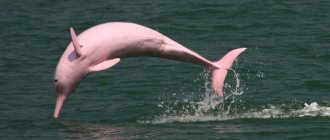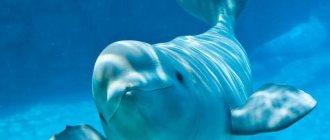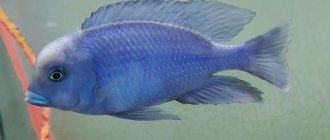The white-faced dolphin belongs to the class of cetaceans and stands out among other dolphins for its particularly large size. It should be noted that this type of animal can be seen quite rarely in a dolphinarium. In most cases, gray dolphins are kept there. Unfortunately, these smart and cute creatures are included in the Red Book, however, in this case this is in no way connected with fishing. The reasons for the decline in the number of representatives of white-faced dolphins have not been precisely established; there are several versions on this matter, and each has a right to exist.
Origin of the species and description
Photo: White-faced dolphin
The body of the animal is very dense, the back is dark or gray, contrasting with the light sides. There is a short snow-white or light gray tail. The dolphin's larynx and belly are white, the dorsal fin is high and protrudes well above the surface of the water. Behind the dorsal fin there is a large light spot.
Typical animal behavior can be described as active:
- movements are fast and energetic, dolphins jump high and often out of the water, amusing those around them with their behavior;
- animals love to accompany passing sea vessels, gliding along the bow wave in full view of passengers and crew;
- usually gather in schools and are found in groups of up to 28 or more individuals, from time to time forming large herds of 200 or more individuals.
To catch fish, dolphins can be organized into mixed herds with a subspecies similar to themselves. They may be a mixture of Atlantic and white-sided dolphins. Sometimes animals can accompany large whales, sharing prey with them and using them as protection for their calves.
Appearance and features
Photo: White-faced dolphin from the Red Book
The length of an ordinary dolphin ranges from 1.5 to 9-10 m. The smallest animal in the world is the Maui species, which lives near New Zealand. The length of this miniature female does not exceed 1.6 meters. The largest inhabitant of the deep sea is the common white-faced dolphin, its length is more than 3 meters.
The largest representative of this class is the killer whale. The length of these males reaches 10 m. Males are usually 10-20 cm larger than females. Animals weigh on average from 150 to 300 kg; a killer whale can weigh a little more than a ton.
The upper area of the body behind the dorsal fin and rounded sides have a grayish-white tint, the belly of the animal has a bright white color. And on the top of the back, in front of the dorsal fin, the dolphin has a grayish-black color. The dorsal fin and flippers are also bright black. The beak of the white-faced dolphin is traditionally white, but is sometimes ash gray.
Video: White-faced dolphin
Dolphins are relatives of whales, so they can stay underwater for a long time. Only occasionally do animals float to the surface of the water and take a breath of air. During sleep, animals float to the surface of the ocean to breathe intuitively, and they do not even wake up. The dolphin is considered the most intelligent mammal on the planet.
The brain weight of this mammal is 1.7 kg, which is 300 grams. more than human, they also have 3 times more convolutions than humans. This fact can explain the highly developed social behavior of the animal, the ability to compassion, the willingness to help unhealthy and wounded individuals or a drowning person.
Moreover, animals help quite rationally and intelligently. If one relative is injured and does not hold well on the surface of the sea, the dolphins will support him so that the patient cannot drown or choke. They do the same thing when rescuing a person, helping a drowning person get to a safe shore. It is impossible to explain such reasonable actions by caring for the population. So far, scientists cannot interpret the friendly behavior of white-faced dolphins, but most of all it looks like reasonable, conscious compassion and adequate help to the victim in difficult situations.
Lifestyle
The lifestyle and behavior of white-faced dolphins are quite interesting. We could talk about this for quite a long time, but we should highlight the following most interesting facts:
- Dolphins of this breed have a fairly playful character - they love to perform various tricks in the water, communicate well with people and are generally not against interesting entertainment;
- underwater, white-faced dolphins also find interesting activities - they simply chase seaweed, which from the outside looks more than funny;
- makes sounds that, if converted into a graphic image, have the shape of a flower. It should be noted that no other animal has such a feature;
- Scientists have found that ultrasound produced by animals has a positive effect on human health. This is actually why dolphin therapy is used to treat not only adults, but also children.
There is also a sad thing - until now, researchers have not determined why white-faced dolphins sometimes wash ashore, which leads to their death. By the way, the gray representatives of this species of animals also have the same unpleasant feature.
Where does the white-beaked dolphin live?
Photo: White-faced dolphin at sea
Under natural conditions, white-faced dolphins live in almost all seas and oceans of the planet. But most of all they are found in the cold Barents Sea, where their number reaches more than 10 thousand individuals.
Animals live in packs; the number of individuals in one pack can reach up to 50 members. Females with their cubs gather in separate flocks, capable of protecting the lives of the younger generation from attacks by predators. Animals do not divide themselves into different subspecies. Individuals of different species, colors and body shapes can live in one flock. These can be Atlantic, white-sided species, etc.
The behavior of dolphins is characterized by frequent jumping out of the water to great heights. Animals feed on small fish, shellfish, crustaceans and other seafood, which leaves no one hungry. Animals can organize a friendly collective hunt, driving a school of fish into a sea gorge or shallow water and thoroughly enjoying their prey in a kind of underwater dining room. Dolphins reach sexual maturity at 7-12 years. Females carry their young for about 11 months. The lifespan of individuals is no more than 30-40 years.
Habitat
If we talk only about the territory of Russia, then white-faced dolphins live in the Baltic or Barents Sea. In general, the natural habitat of these animals is the northern part of the Atlantic. But as for the migration of dolphins of this species, it has not yet been well studied.
If we talk about their natural living environment, these white-breasted beauties do not like to be alone. As a rule, they gather in herds of 6-8 individuals. It is noteworthy that sometimes dolphins live only in pairs. It is not so uncommon for a dolphin to live with one female its entire life.
It should be noted that quite rarely, but still sometimes they gather in schools of 1000-1500 dolphins. As a rule, such accumulations can only be found in places where there is a large amount of food. But, in situations where food becomes very scarce, they break up into small flocks.
What does the white-beaked dolphin eat?
Photo: Red Book white-faced dolphin
The diet of the white-faced dolphin contains all the fish products that the world's oceans are rich in. They do not disdain shrimp or squid, they love to eat large or small fish, and can even hunt small birds. When fishing, dolphins can use different methods, including collective ones.
To do this, intelligent animals do the following:
- send scouts to search for a school of fish;
- surround a school of fish from all sides and then feed;
- They drive the fish into shallow water, and then catch them there and eat them.
Features of character and lifestyle
Photo: White-faced dolphin
Many members of the dolphin family, such as bottlenose dolphins, white-faced dolphins, and white-sided dolphins, usually live in the salty abysses of the sea. But there are species that thrive in fresh water, living in large lakes and rivers. The white-faced river dolphin is found in the Amazon and Orinoco, large American rivers, and has also been spotted in Asian waters.
Due to increasing pollution of the natural habitat, populations of river dolphin species are beginning to decline. Therefore, they are listed in the Red Book and are protected by law.
Diseases
This species is poorly studied, so almost nothing is known about the diseases. There is reliable data only on some bone diseases and dental abscesses. There are also three types of parasitic worms that have been found in the bodies of some dolphins.
White-beaked dolphins are also associated with a phenomenon that science cannot yet explain. The point is that some individuals dry out for unknown reasons. Over the last century, several hundred similar cases have been noted, in various parts of their habitat.
Scientists also don’t know how to deal with this yet, but they are trying to find an answer, using all the forces and resources that modern science has to do so.
Social structure and reproduction
Photo: White-faced dolphins
Scientists have proven that all species of dolphins use sign language to communicate with each other. This can be jumping or turning, movements of the head or fins, peculiar wagging of the tail, etc.
Also, smart animals can communicate with each other using special sounds. Researchers counted more than 14 thousand different sound vibrations similar to songs. There are legends and fairy tales about the songs of dolphins on the coasts of the oceans around the world.
The hearing aid of dolphins can perceive up to 200,000 sound vibrations per second, while humans perceive only 20,000.
Animals are good at separating one sound signal from another, easily dividing it into separate frequencies. With the help of various ultrasonic vibrations, animals can transmit important information to each other underwater over vast distances. In addition to songs, individuals can produce crackling, clicking, creaking, and whistling sounds.
Dolphins can warn their fellows about danger, report the approach of a large school of fish, and males call females to mate. Individuals transmit a huge amount of necessary and useful information to each other in the depths of the ocean, using the echo-conducting abilities of water.
There are two types of sounds made by dolphins:
- Echolocation or echo of sounds made;
- Sonar or the sounds themselves that an individual produces;
- The researchers counted more than 180 different sounds, in which syllables, words, phrases and even different dialects could be clearly distinguished.
Females reach their sexually mature level at the age of 5 years and become full-fledged adults, capable of conceiving and bearing offspring. Males mature a little longer and gain the ability to fertilize only at 10 years of age. Animals can create married couples, but cannot maintain marital fidelity for a long time, so after the birth of offspring, the couples break up.
Typically, dolphin births occur in the summer. During childbirth, the female tries to stay close to the surface of the water in order to immediately push the baby into the air and take its first breath. The baby is always born alone, has a size of up to 500 cm. The mother feeds him with milk for up to 6 months, guarding and protecting him from all kinds of enemies. In the first month of life, the dolphin cubs do not sleep at all and the mother is forced to monitor their behavior around the clock, taking care of the safety of her offspring.
Natural enemies of white-beaked dolphins
Photo: White-faced dolphin from the Red Book
The main sources of threat to white-beaked dolphins are people, their livelihoods and methods of capture. Great harm to the dolphin population is caused by industrial emissions of chemical waste, which is often dumped directly into the sea by careless owners.
The peace-loving, large and active animal has virtually no natural enemies. Some mammals die when they get caught in fishing nets along with fish. Sharks can attack baby dolphins, trying to take the baby away from the mother and feast on the tender meat of the baby dolphin. But such attempts are rarely crowned with success, since the dolphin is capable of giving a worthy rebuff to any opponent, and her relatives will not remain indifferent and will help in the unequal struggle.
Despite the fact that dolphins are not commercially fished and are not caught on a large scale, some countries allow the capture of these animals for subsequent use in the food industry and for commercial use.
Method number 3. Advanced level
Step 1
Draw the basic curve. It will go through the center of the body.
Step 2
Find the middle of this curve.
Step 3
Divide each half of the curve into halves. This will help us with proportions.
Step 4
Draw a circle in the first quarter of the curve. It doesn't have to be a perfect circle!
Step 5
Draw an oval across another two quarters of the line. Place it so that the curve goes straight through it.
Step 6
Draw a series of circles, like beads on a string, until you reach the end of the curve. Make each one smaller than the previous one.
Step 7
Let's add some perspective to the body to make it more realistic. Draw an oval on the front of the head, creating a flat "face".
Step 8
Cross the muzzle in the middle with a straight line to better see this plane.
Step 9
Did you see the body shape? Draw a line along his side. Remember that you decide where your dolphin's side is located.
Step 10
Draw a line through the lower part of the body. It must follow the side line.
Step 11
Outline the entire body shape on both sides, following it.
Step 12
You can add additional lines to create shapes along the body. They make it easier to see the depth of the drawing.
Population and species status
Photo: White-faced dolphin in the ocean
The exact number of individuals of the white-faced dolphin living in the seas and oceans of the world is unknown. The estimated population is 200-300 thousand individuals. The white-beaked dolphin is most abundant in the following areas:
- in the North Atlantic;
- in the adjacent seas of Davis Strait and Cape Cod;
- in the Barents and Baltic seas;
- in the southern coastal waters of Portugal;
- found in Turkey and the coastal waters of Crimea.
Adult representatives of the white-faced species are in a fairly stable position. The white-faced dolphin is listed in the Red Book as a rare and little-studied natural phenomenon that needs protection and conservation.
Fish world
The representation of marine inhabitants of the White Sea, in contrast to the neighboring Barents Sea, is more meager. Although about seventy species of fish can be distinguished here. They live at a depth of up to 30 meters, where there is food.
Fishing for cod, herring, salmon, flounder, and sea bass is widely developed here. Fishing for smelt from ice is very popular among residents of the White Sea shores.
Pacific herring are the most common schooling fish in this area. Navaga and Arctic cod enter the waters of the White Sea in winter to lay eggs. Cod representatives: cod, navaga and pollock spend the winter here. There are two species of flounder found in the White Sea. One of them - sea flounder - comes here from the Barents Sea to fatten. Another species is the polar flounder. She lives in the White Sea permanently.











